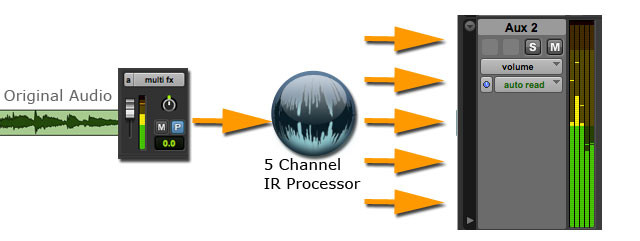Multi-channel convolution reverb
![]() Author: Guido Helbling, Avosound - last updated June 20, 2017
Author: Guido Helbling, Avosound - last updated June 20, 2017
Multi-channel convolution reverb now differs only in the number of channels for true stereo.
![]() Author: Guido Helbling, Avosound - last updated June 20, 2017
Author: Guido Helbling, Avosound - last updated June 20, 2017
Multi-channel convolution reverb now differs only in the number of channels for true stereo.

Figure 17 shows the recording of an impulse response with five channels. Each microphone position receives the specific spatial information according to the proportions of direct and diffuse sound. Naturally, the centre microphone absorbs most of the direct sound as it is closest to the sound source. The surround channels are positioned in the reverberation zone and therefore take on a much greater proportion of diffuse sound and reverberation. This is also clearly evident in the waveforms of the impulse responses.
The playback of the five-channel impulse responses now accurately reflects the mono signal with the acoustic information from the recorded space: the center channel signal, which stood closest to the speaker in the recording, now also peaks the most in the playback compared to the left and right channels, while the surround channels provide the reverberation (see Figure 18).

If one wants to add reverb to a stereo signal in 5.1 space, the spatial information of the left and right positions is required in true stereo. This is obtained - exactly as with true stereo - by recording with five microphones instead of two.

Figure 19 shows the recording situation of the left stereo channel with five audio channels. With the speaker, the entire space of the left side is stimulated acoustically and produces reflections that are strongly absorbed mainly from the left side rather than the right. The waveforms in the record show this clearly: the waveforms of the left-hand side are significantly more pronounced than those of the right.
For stereo reproduction, the right side is still needed here, resulting in the corresponding waveforms and impulse responses for the right side
The waveforms of the impulse responses are not always as beautifully obvious as the ones I prepared specially for this tutorial. If the levels of the recording channels were as diverse in Figure 19, the result would point to a huge room with a considerable distance between the microphones. While this may be quite possible outdoors, it is hardly true of large halls and rooms.
Recording multi-channel impulse responses is always dependent on the system. Hence if you want to make impulse responses for a particular plug-in, it is essential to know the specifications of the system. Altiverb generates the centre channel itself and requires a multi-channel impulse response only for four channels without center. TL Space needs for each channel an impulse response and two of them for stereo playback. Space Designer can do what all others can't: Space Designer could technically generate reverb for 5-channel to 5-channel with a total of 25 channel impulse responses! Whether this makes sense is anyone's guess. Besides, this only really matters for people who work with Apple programs, as Space Designer runs only with Logic (and then only if you have a lot of horsepower in your computer).
It is possible for the waveforms of surround channels to be more pronounced than those from the front. Assuming that no channels were incorrectly patched (which can happen rather easily), this points to acoustic problems or peculiarities of the recording position. The expression of the impulse response does not necessarily mean that the entire impulse response is louder than, say, a channel from the front; however, certain frequencies are particularly pronounced. This can cause rumbling resonances or standing waves that appear naturally during the playback of sweeps – just like reflections.
If you have been trying to avoid dealing with acoustics, you will definitively need to brush up on the subject when dealing with impulse responses. We continue on the next page.
Author: Guido Helbling, Avosound